人教版(2019) 选择性必修第三册 Unit 5 Poems Using Language课件(32张)
文档属性
| 名称 | 人教版(2019) 选择性必修第三册 Unit 5 Poems Using Language课件(32张) |  | |
| 格式 | zip | ||
| 文件大小 | 4.6MB | ||
| 资源类型 | 教案 | ||
| 版本资源 | 人教版(2019) | ||
| 科目 | 英语 | ||
| 更新时间 | 2022-05-27 16:59:37 | ||
图片预览

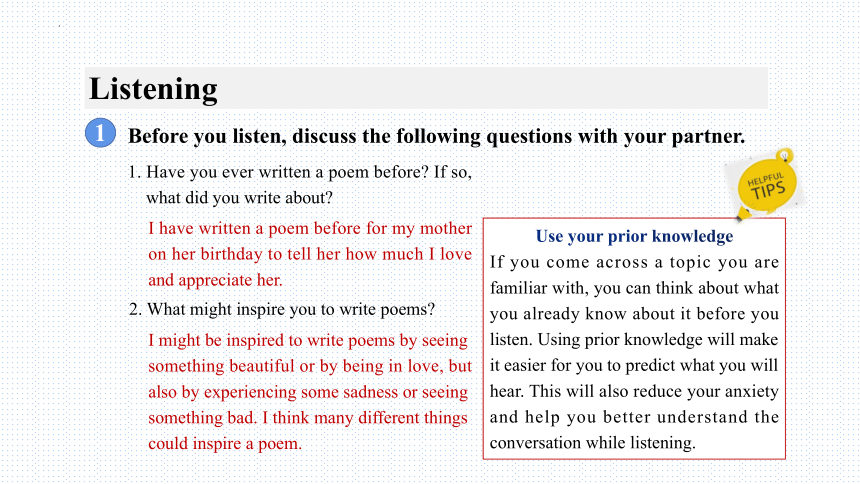

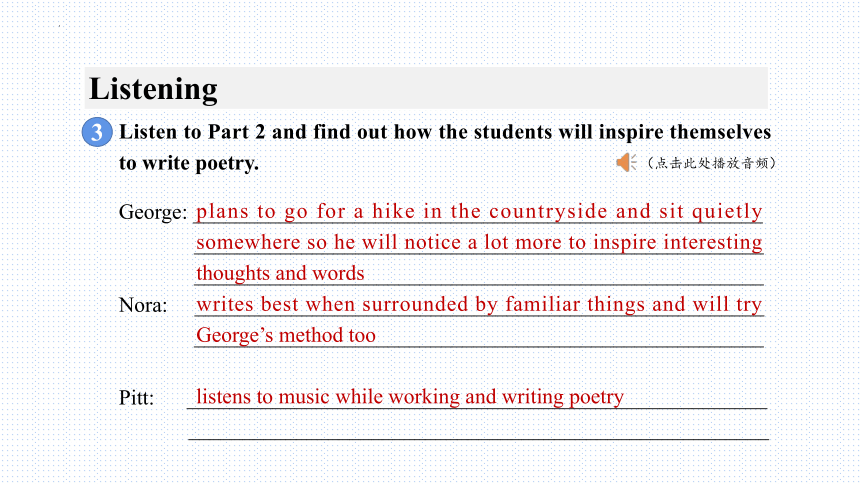
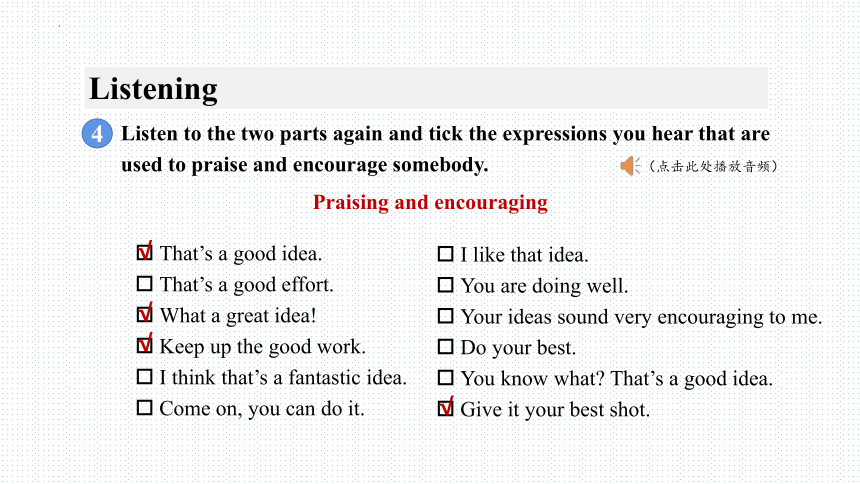
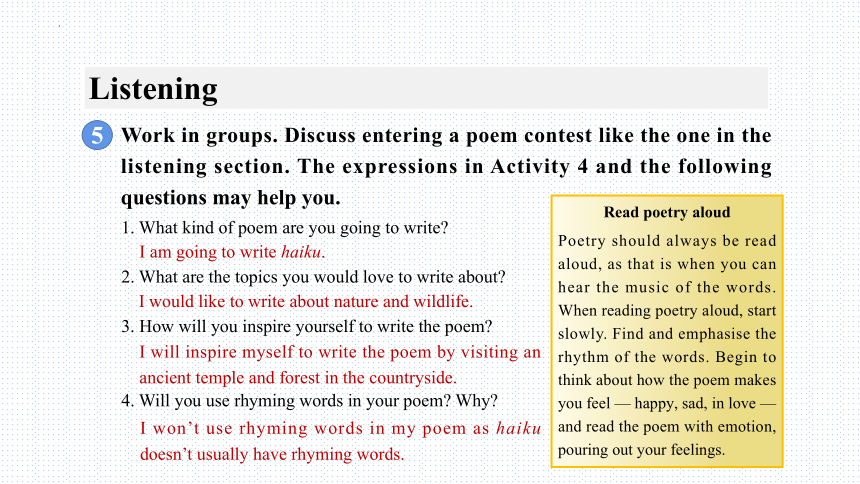
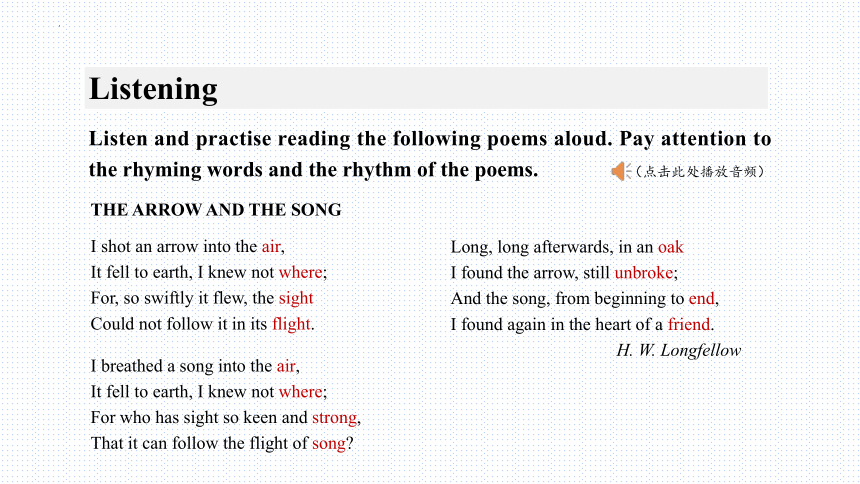
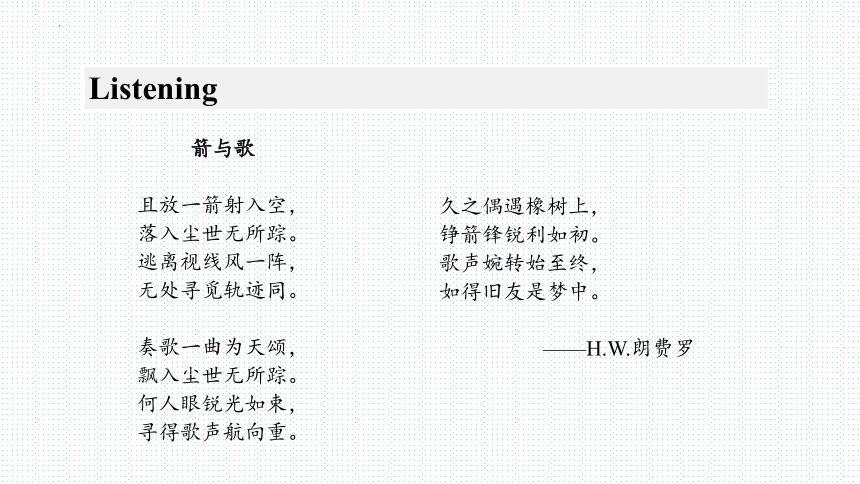

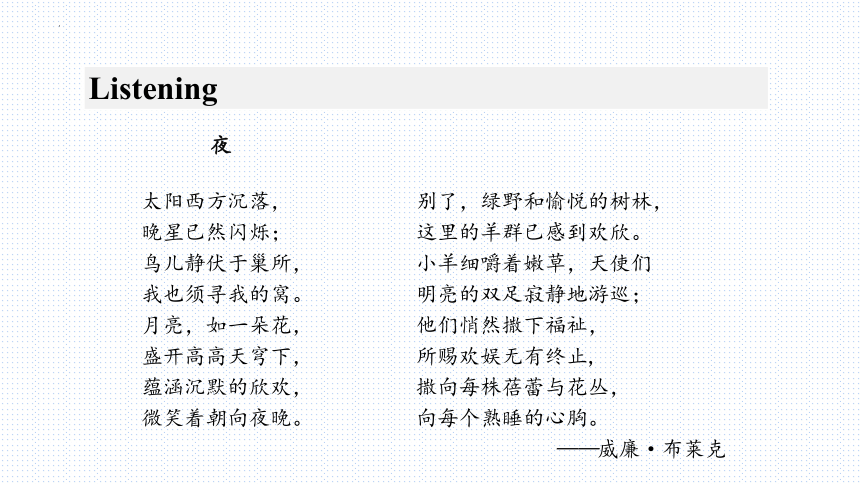
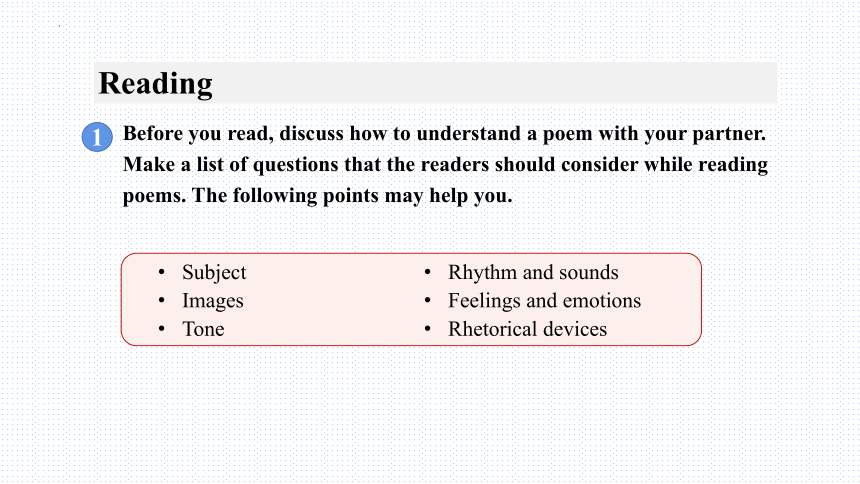
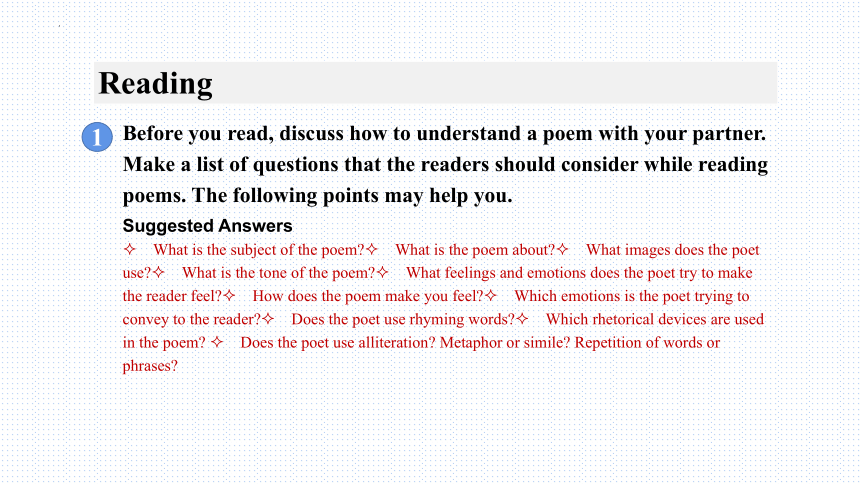
文档简介
(共32张PPT)
Unit 5 Poems
Using Language
Listening
Before you listen, discuss the following questions with your partner.
1
1. Have you ever written a poem before If so, what did you write about
2. What might inspire you to write poems
Use your prior knowledge
If you come across a topic you are familiar with, you can think about what you already know about it before you listen. Using prior knowledge will make it easier for you to predict what you will hear. This will also reduce your anxiety and help you better understand the conversation while listening.
I have written a poem before for my mother on her birthday to tell her how much I love and appreciate her.
I might be inspired to write poems by seeing something beautiful or by being in love, but also by experiencing some sadness or seeing something bad. I think many different things could inspire a poem.
You are going to listen to a conversation between a teacher and her students about a poetry contest. Listen to Part 1 and answer the questions.
2
(点击此处播放音频)
1. When is the deadline for the poetry contest
2. What does Nora mean by saying that she needs time to polish her writing
3. Why doesn’t Pitt want to enter a poem contest
4. What does George plan to do
n. 最后期限;截止日期
n. 比赛;竞赛
vt. 修改;润色
The deadline for the poetry contest is 24 June.
Nora means it’s not finished, and she needs some time to change it and make it better.
Pitt doesn’t want to enter a poem contest because he can’t think of anything to write about.
George plans to write his poem on the weekend but only if he feels inspired.
Listening
Listen to Part 2 and find out how the students will inspire themselves to write poetry.
3
(点击此处播放音频)
George: _____________________________________________________
_____________________________________________________
_____________________________________________________
Nora: _____________________________________________________
_____________________________________________________
Pitt: ______________________________________________________
______________________________________________________
plans to go for a hike in the countryside and sit quietly somewhere so he will notice a lot more to inspire interesting thoughts and words
writes best when surrounded by familiar things and will try George’s method too
listens to music while working and writing poetry
Listening
Listen to the two parts again and tick the expressions you hear that are used to praise and encourage somebody.
4
(点击此处播放音频)
That’s a good idea.
That’s a good effort.
What a great idea!
Keep up the good work.
I think that’s a fantastic idea.
Come on, you can do it.
I like that idea.
You are doing well.
Your ideas sound very encouraging to me.
Do your best.
You know what That’s a good idea.
Give it your best shot.
Praising and encouraging
√
√
√
√
Listening
Work in groups. Discuss entering a poem contest like the one in the listening section. The expressions in Activity 4 and the following questions may help you.
5
1. What kind of poem are you going to write
2. What are the topics you would love to write about
3. How will you inspire yourself to write the poem
4. Will you use rhyming words in your poem Why
Read poetry aloud
Poetry should always be read aloud, as that is when you can hear the music of the words. When reading poetry aloud, start slowly. Find and emphasise the rhythm of the words. Begin to think about how the poem makes you feel — happy, sad, in love — and read the poem with emotion, pouring out your feelings.
I am going to write haiku.
I would like to write about nature and wildlife.
I will inspire myself to write the poem by visiting an ancient temple and forest in the countryside.
I won’t use rhyming words in my poem as haiku doesn’t usually have rhyming words.
Listening
Listen and practise reading the following poems aloud. Pay attention to the rhyming words and the rhythm of the poems.
THE ARROW AND THE SONG
I shot an arrow into the air,
It fell to earth, I knew not where;
For, so swiftly it flew, the sight
Could not follow it in its flight.
I breathed a song into the air,
It fell to earth, I knew not where;
For who has sight so keen and strong,
That it can follow the flight of song
Long, long afterwards, in an oak
I found the arrow, still unbroke;
And the song, from beginning to end,
I found again in the heart of a friend.
H. W. Longfellow
(点击此处播放音频)
Listening
箭与歌
且放一箭射入空,
落入尘世无所踪。
逃离视线风一阵,
无处寻觅轨迹同。
奏歌一曲为天颂,
飘入尘世无所踪。
何人眼锐光如束,
寻得歌声航向重。
久之偶遇橡树上,
铮箭锋锐利如初。
歌声婉转始至终,
如得旧友是梦中。
——H.W.朗费罗
Listening
Listen and practise reading the following poems aloud. Pay attention to the rhyming words and the rhythm of the poems.
NIGHT
The sun descending in the west,
The evening star does shine;
The birds are silent in their nest,
And I must seek for mine.
The moon, like a flower,
In heaven’s high bower,
With silent delight,
Sits and smiles on the night.
Farewell, green fields and happy groves,
Where flocks have took delight.
Where lambs have nibbled, silent moves
The feet of angels bright;
Unseen, they pour blessing,
And joy without ceasing,
On each bud and blossom,
And each sleeping bosom.
William Blake
(点击此处播放音频)
Listening
夜
太阳西方沉落,
晚星已然闪烁;
鸟儿静伏于巢所,
我也须寻我的窝。
月亮,如一朵花,
盛开高高天穹下,
蕴涵沉默的欣欢,
微笑着朝向夜晚。
别了,绿野和愉悦的树林,
这里的羊群已感到欢欣。
小羊细嚼着嫩草,天使们
明亮的双足寂静地游巡;
他们悄然撒下福祉,
所赐欢娱无有终止,
撒向每株蓓蕾与花丛,
向每个熟睡的心胸。
——威廉·布莱克
Listening
Before you read, discuss how to understand a poem with your partner. Make a list of questions that the readers should consider while reading poems. The following points may help you.
1
Reading
Rhythm and sounds
Feelings and emotions
Rhetorical devices
Subject
Images
Tone
Suggested Answers
What is the subject of the poem What is the poem about What images does the poet use What is the tone of the poem What feelings and emotions does the poet try to make the reader feel How does the poem make you feel Which emotions is the poet trying to convey to the reader Does the poet use rhyming words Which rhetorical devices are used in the poem Does the poet use alliteration Metaphor or simile Repetition of words or phrases
Before you read, discuss how to understand a poem with your partner. Make a list of questions that the readers should consider while reading poems. The following points may help you.
1
Reading
1. I couldn’t keep up with it, ...
我跟不上它……
keep up with 跟上,不落人之后;对……消息灵通;保持接触
① I can’t keep up with all the changes.
我并非所有的变化都能跟得上。
② She did not bother to keep up with the latest news.
她不愿花时间去了解最新的消息。
③ Many people were holding down three jobs just to keep up with the Joneses.
许多人同时做3份工作只不过是为了和别人攀比。
Reading
【词汇拓展】
keep on 继续;反复做
keep (sb/sth) from sth 不让(某人)做某事;不让(某事)发生
keep in touch with 与······保持联系
① You just have to keep on trying.
你可得继续努力。
② I hope I haven’t kept you from your work.
我希望我没有妨碍你的工作。
③ We must keep in touch with each other.
大家要经常通气。
Reading
string n. 细绳;线;一串 vt. 悬挂;系 adj. 弦乐器的;线织的
① Shall I tie all these things together with string
要我把这些东西全部用细绳捆在一起吗?
② Lanterns were strung in the trees around the pool.
水池周围的树上悬挂着灯笼。
③ String instruments are a category of musical instrument.
弦乐器是乐器的一种。
2. But if I stopped holding 但如果我不再紧握
The string of my kite, 我手中的风筝线,
Reading
wherever 此处相当于no matter where,引导让步状语从句。
① Wherever he hides, the police will catch him.
不论他藏在哪里,警方都会抓住他。
② I’ll go wherever he goes.
我将去他所去的任何地方。
3. Wherever it blew, 无论它吹到任何地方,
I should know that the wind 我会知道风
Had been going there too. 也曾经去过那里。
Reading
barren adj. 贫瘠的;不结果实的
① No crops can be grown on this barren land.
这片贫瘠的土地无法种植庄稼。
② He also wants to use the water to irrigate barren desert land.
他也想用这些水灌溉荒漠。
4. Life is a barren field 生活变成荒芜的田野
Frozen with snow. 被冰封雪盖。
Reading
5. Green pleasure or grey grief;
感受绿色的欢乐或灰色的苦闷;
grief n. 悲伤;悲痛;伤心事
① She was out of her mind with grief.
她悲痛得精神失常了。
② They were able to share their common joys and griefs.
他们做到了同甘共苦。
Reading
WIND ON THE HILL
No one can tell me,
Nobody knows,
Where the wind comes from,
Where the wind goes.
It’s flying from somewhere
As fast as it can,
I couldn’t keep up with it,
Not if I ran.
山上的风
没有人能够告诉我,
也没有人会知道,
风来自哪里,
又将去往何处。
它从一个地方吹来
尽它所能,飞快地吹来,
我不能赶上它,
即使我奔跑。
Reading
Read the poems below and then complete the table.
2
Wind on the Hill Dream A Match
Subject
Images
Rhyming words
Rhetorical devices
the wind
dreams
love
knows/goes
can/ran
kite/night
blew/too
goes/knows
repetition
alliteration
die/fly
go/snow
repetition
metaphor
together/weather
closes/is
grief/leaf
repetition
metaphor, simile
rose, leaf, fields
broken-winged bird,
barren field frozen with snow
kite, person
Reading
Choose one of the poems and write a short essay about it. The following example may help you.
3
The poem Dream by Langston Hughes is very short with only 8 lines. When I read the poem aloud I can hear that the ends of the second and fourth sentences rhyme — “die” and “fly”. The last word from the sixth and eighth sentences also rhyme — “go” and “snow”. These rhyming words sound nice and make the poem pleasing to read.
When I close my eyes, I can see different images from the poem. For example, I can see two hands being held. I can see a bird flying in the sky. I can see a field and I can imagine what it looks like with lots of snow. I start to feel cold when I read these lines!
I learnt a new phrase, “hold fast”, which means to hold onto something. “Barren” is also a new word to me, which means empty.
I think the poet is giving us advice. He wants us to keep dreaming, because life is much better when we dream and have something to look forward to.
Writing
How to write a short essay about a poem
如何写诗歌赏析类文章
写法一 通过对全诗的整体分析,表达自己的观点。 写法二
就诗歌最突出的方面进行分析,表达自己的见解。
Writing
写法一
一篇较完整的诗歌赏析类文章一般包含如下内容:
1. 作者简介
2. 作品写作背景简介
3. 作品意象分析(诗句的解释或翻译,诗句所表达的情感、思想和意境)
4. 作品的艺术手法分析(通常结合在作品意象分析之中)
5. 作品艺术特点的综合评价(常带有总结的意味)
写法二
采用这种写法时,作者只需要抓住其中一个方面,如意境、语言表达、某一手法等。对于其他方面则可不提及,因而采用这种写法的文章篇幅一般较短小。
Writing
体 裁 人 称 时 态 要 点 结 构 图 开头 点题 提炼出诗歌中所包含的信息。
议论文 以第三人称 为主 1. 一般现在时 2. 一般过去时 主体 段落 多种方式表达、层次分明、结构清晰、过渡自然。
结尾 针对诗歌中所提供的信息,发表自己的观点。
写作布局
Writing
Here is a poem titled ... by ...
It is popular with Chinese readers.
This poem is about nature and life.
It is written with special writing skills.
It rhymes at the end of each line.
The language of the poem is descriptive and vivid.
Whenever we read this poem, some characters appear clearly.
Only by reading it repeatedly can we grasp the spirit of this poem.
Considered as one of the greatest poets of the Tang Dynasty, … will undoubtedly live in people’s heart forever.
In my opinion, the young generation today should understand the poem and learnt from it.
Useful expressions
Writing
Write your own poem by following these steps.
4
Start with the theme first. Ask yourself, “What message do I want to give to the reader What is important to me ”
Next, think about the words and phrases you would like to use. Make a list of words related to your theme.
Then check how well your details paint a picture in your need. Now write the poem. Read it aloud and listen to how it sounds.
Finally, give it a title. Now your poem is ready!
Part 3 Writing
如何写英文诗歌
诗歌是高度概括、反映社会生活的文学体裁,也是最富有激情和感彩的体裁。诗歌往往用高度凝练的语言来表达诗人的喜怒哀乐,诗人把自己对生活和客观世界的理解和感悟融入诗中。诗歌以其特有的节奏与方式影响人们的精神世界,饱含着作者丰富的思想感情。
Writing
写作要点
1. 目的明确
人们写诗歌出于各种各样的目的,有的是为了讲述一个故事,有的是为了表达感情,有的是为了描述事物等。
2. 内容充实
诗歌要言之有物,传达出作者对外在世界的独特感受,所表现的题材要有深刻丰富的内心体验。
3. 形式适当
在写诗歌时要注意选择一种既能实现写作目的又能驾驭的形式。
Writing
4. 语言得当
诗歌的语言不同于我们的日常用语,也不同于一般的小说和散文的语言。诗人只有对实用语言加以“破坏、改造”,如英国著名诗人艾略特所说的那样“扭断语法的脖子”,才能使之成为诗歌的语言。
5. 有节奏感
在语言的外观上,诗歌通常是以分行排列的方式呈现,且要有和谐的音韵和鲜明的节奏。诗歌的押韵是指通过重复元音或辅音以达到一定的音韵效果,一首诗歌的押韵具有一定的规律,尤其是在诗句的末尾,即尾韵。
写作要点
Writing
五行诗
第一行:一个名词(主题);
第二行:两个形容词(描写主题);
第三行:三个动词-ing形式(与主题相关的动作);
第四行:四个词(作者感受);
第五行:一个词(回归主题)。
Kitty
Naughty, sleepy
Chasing, tearing, licking
Day in, night out
Meow
Writing
清单诗
可长可短,可以重复一些短语,形成固定句型和诗的节奏。可以有韵脚,也可以没有。
What moves me
It moves me ...
When my family around the table have holiday feasts.
When my father mends my bicycle with oil-covered hands.
When my mother waits a long time for me at the school gate.
When my grandpa holds Grandma’s hands while crossing the street.
When my sister sings a sweet lullaby to her baby.
When my pet cat licks her kittens softly.
Writing
Write your own poem.
Take turns to read aloud your poems and then have a discussion on what you think they mean. Give your personal opinion or advice based on what you have learnt from this unit.
Read aloud your poem to the class or put it up in the classroom.
Writing
Unit 5 Poems
Using Language
Listening
Before you listen, discuss the following questions with your partner.
1
1. Have you ever written a poem before If so, what did you write about
2. What might inspire you to write poems
Use your prior knowledge
If you come across a topic you are familiar with, you can think about what you already know about it before you listen. Using prior knowledge will make it easier for you to predict what you will hear. This will also reduce your anxiety and help you better understand the conversation while listening.
I have written a poem before for my mother on her birthday to tell her how much I love and appreciate her.
I might be inspired to write poems by seeing something beautiful or by being in love, but also by experiencing some sadness or seeing something bad. I think many different things could inspire a poem.
You are going to listen to a conversation between a teacher and her students about a poetry contest. Listen to Part 1 and answer the questions.
2
(点击此处播放音频)
1. When is the deadline for the poetry contest
2. What does Nora mean by saying that she needs time to polish her writing
3. Why doesn’t Pitt want to enter a poem contest
4. What does George plan to do
n. 最后期限;截止日期
n. 比赛;竞赛
vt. 修改;润色
The deadline for the poetry contest is 24 June.
Nora means it’s not finished, and she needs some time to change it and make it better.
Pitt doesn’t want to enter a poem contest because he can’t think of anything to write about.
George plans to write his poem on the weekend but only if he feels inspired.
Listening
Listen to Part 2 and find out how the students will inspire themselves to write poetry.
3
(点击此处播放音频)
George: _____________________________________________________
_____________________________________________________
_____________________________________________________
Nora: _____________________________________________________
_____________________________________________________
Pitt: ______________________________________________________
______________________________________________________
plans to go for a hike in the countryside and sit quietly somewhere so he will notice a lot more to inspire interesting thoughts and words
writes best when surrounded by familiar things and will try George’s method too
listens to music while working and writing poetry
Listening
Listen to the two parts again and tick the expressions you hear that are used to praise and encourage somebody.
4
(点击此处播放音频)
That’s a good idea.
That’s a good effort.
What a great idea!
Keep up the good work.
I think that’s a fantastic idea.
Come on, you can do it.
I like that idea.
You are doing well.
Your ideas sound very encouraging to me.
Do your best.
You know what That’s a good idea.
Give it your best shot.
Praising and encouraging
√
√
√
√
Listening
Work in groups. Discuss entering a poem contest like the one in the listening section. The expressions in Activity 4 and the following questions may help you.
5
1. What kind of poem are you going to write
2. What are the topics you would love to write about
3. How will you inspire yourself to write the poem
4. Will you use rhyming words in your poem Why
Read poetry aloud
Poetry should always be read aloud, as that is when you can hear the music of the words. When reading poetry aloud, start slowly. Find and emphasise the rhythm of the words. Begin to think about how the poem makes you feel — happy, sad, in love — and read the poem with emotion, pouring out your feelings.
I am going to write haiku.
I would like to write about nature and wildlife.
I will inspire myself to write the poem by visiting an ancient temple and forest in the countryside.
I won’t use rhyming words in my poem as haiku doesn’t usually have rhyming words.
Listening
Listen and practise reading the following poems aloud. Pay attention to the rhyming words and the rhythm of the poems.
THE ARROW AND THE SONG
I shot an arrow into the air,
It fell to earth, I knew not where;
For, so swiftly it flew, the sight
Could not follow it in its flight.
I breathed a song into the air,
It fell to earth, I knew not where;
For who has sight so keen and strong,
That it can follow the flight of song
Long, long afterwards, in an oak
I found the arrow, still unbroke;
And the song, from beginning to end,
I found again in the heart of a friend.
H. W. Longfellow
(点击此处播放音频)
Listening
箭与歌
且放一箭射入空,
落入尘世无所踪。
逃离视线风一阵,
无处寻觅轨迹同。
奏歌一曲为天颂,
飘入尘世无所踪。
何人眼锐光如束,
寻得歌声航向重。
久之偶遇橡树上,
铮箭锋锐利如初。
歌声婉转始至终,
如得旧友是梦中。
——H.W.朗费罗
Listening
Listen and practise reading the following poems aloud. Pay attention to the rhyming words and the rhythm of the poems.
NIGHT
The sun descending in the west,
The evening star does shine;
The birds are silent in their nest,
And I must seek for mine.
The moon, like a flower,
In heaven’s high bower,
With silent delight,
Sits and smiles on the night.
Farewell, green fields and happy groves,
Where flocks have took delight.
Where lambs have nibbled, silent moves
The feet of angels bright;
Unseen, they pour blessing,
And joy without ceasing,
On each bud and blossom,
And each sleeping bosom.
William Blake
(点击此处播放音频)
Listening
夜
太阳西方沉落,
晚星已然闪烁;
鸟儿静伏于巢所,
我也须寻我的窝。
月亮,如一朵花,
盛开高高天穹下,
蕴涵沉默的欣欢,
微笑着朝向夜晚。
别了,绿野和愉悦的树林,
这里的羊群已感到欢欣。
小羊细嚼着嫩草,天使们
明亮的双足寂静地游巡;
他们悄然撒下福祉,
所赐欢娱无有终止,
撒向每株蓓蕾与花丛,
向每个熟睡的心胸。
——威廉·布莱克
Listening
Before you read, discuss how to understand a poem with your partner. Make a list of questions that the readers should consider while reading poems. The following points may help you.
1
Reading
Rhythm and sounds
Feelings and emotions
Rhetorical devices
Subject
Images
Tone
Suggested Answers
What is the subject of the poem What is the poem about What images does the poet use What is the tone of the poem What feelings and emotions does the poet try to make the reader feel How does the poem make you feel Which emotions is the poet trying to convey to the reader Does the poet use rhyming words Which rhetorical devices are used in the poem Does the poet use alliteration Metaphor or simile Repetition of words or phrases
Before you read, discuss how to understand a poem with your partner. Make a list of questions that the readers should consider while reading poems. The following points may help you.
1
Reading
1. I couldn’t keep up with it, ...
我跟不上它……
keep up with 跟上,不落人之后;对……消息灵通;保持接触
① I can’t keep up with all the changes.
我并非所有的变化都能跟得上。
② She did not bother to keep up with the latest news.
她不愿花时间去了解最新的消息。
③ Many people were holding down three jobs just to keep up with the Joneses.
许多人同时做3份工作只不过是为了和别人攀比。
Reading
【词汇拓展】
keep on 继续;反复做
keep (sb/sth) from sth 不让(某人)做某事;不让(某事)发生
keep in touch with 与······保持联系
① You just have to keep on trying.
你可得继续努力。
② I hope I haven’t kept you from your work.
我希望我没有妨碍你的工作。
③ We must keep in touch with each other.
大家要经常通气。
Reading
string n. 细绳;线;一串 vt. 悬挂;系 adj. 弦乐器的;线织的
① Shall I tie all these things together with string
要我把这些东西全部用细绳捆在一起吗?
② Lanterns were strung in the trees around the pool.
水池周围的树上悬挂着灯笼。
③ String instruments are a category of musical instrument.
弦乐器是乐器的一种。
2. But if I stopped holding 但如果我不再紧握
The string of my kite, 我手中的风筝线,
Reading
wherever 此处相当于no matter where,引导让步状语从句。
① Wherever he hides, the police will catch him.
不论他藏在哪里,警方都会抓住他。
② I’ll go wherever he goes.
我将去他所去的任何地方。
3. Wherever it blew, 无论它吹到任何地方,
I should know that the wind 我会知道风
Had been going there too. 也曾经去过那里。
Reading
barren adj. 贫瘠的;不结果实的
① No crops can be grown on this barren land.
这片贫瘠的土地无法种植庄稼。
② He also wants to use the water to irrigate barren desert land.
他也想用这些水灌溉荒漠。
4. Life is a barren field 生活变成荒芜的田野
Frozen with snow. 被冰封雪盖。
Reading
5. Green pleasure or grey grief;
感受绿色的欢乐或灰色的苦闷;
grief n. 悲伤;悲痛;伤心事
① She was out of her mind with grief.
她悲痛得精神失常了。
② They were able to share their common joys and griefs.
他们做到了同甘共苦。
Reading
WIND ON THE HILL
No one can tell me,
Nobody knows,
Where the wind comes from,
Where the wind goes.
It’s flying from somewhere
As fast as it can,
I couldn’t keep up with it,
Not if I ran.
山上的风
没有人能够告诉我,
也没有人会知道,
风来自哪里,
又将去往何处。
它从一个地方吹来
尽它所能,飞快地吹来,
我不能赶上它,
即使我奔跑。
Reading
Read the poems below and then complete the table.
2
Wind on the Hill Dream A Match
Subject
Images
Rhyming words
Rhetorical devices
the wind
dreams
love
knows/goes
can/ran
kite/night
blew/too
goes/knows
repetition
alliteration
die/fly
go/snow
repetition
metaphor
together/weather
closes/is
grief/leaf
repetition
metaphor, simile
rose, leaf, fields
broken-winged bird,
barren field frozen with snow
kite, person
Reading
Choose one of the poems and write a short essay about it. The following example may help you.
3
The poem Dream by Langston Hughes is very short with only 8 lines. When I read the poem aloud I can hear that the ends of the second and fourth sentences rhyme — “die” and “fly”. The last word from the sixth and eighth sentences also rhyme — “go” and “snow”. These rhyming words sound nice and make the poem pleasing to read.
When I close my eyes, I can see different images from the poem. For example, I can see two hands being held. I can see a bird flying in the sky. I can see a field and I can imagine what it looks like with lots of snow. I start to feel cold when I read these lines!
I learnt a new phrase, “hold fast”, which means to hold onto something. “Barren” is also a new word to me, which means empty.
I think the poet is giving us advice. He wants us to keep dreaming, because life is much better when we dream and have something to look forward to.
Writing
How to write a short essay about a poem
如何写诗歌赏析类文章
写法一 通过对全诗的整体分析,表达自己的观点。 写法二
就诗歌最突出的方面进行分析,表达自己的见解。
Writing
写法一
一篇较完整的诗歌赏析类文章一般包含如下内容:
1. 作者简介
2. 作品写作背景简介
3. 作品意象分析(诗句的解释或翻译,诗句所表达的情感、思想和意境)
4. 作品的艺术手法分析(通常结合在作品意象分析之中)
5. 作品艺术特点的综合评价(常带有总结的意味)
写法二
采用这种写法时,作者只需要抓住其中一个方面,如意境、语言表达、某一手法等。对于其他方面则可不提及,因而采用这种写法的文章篇幅一般较短小。
Writing
体 裁 人 称 时 态 要 点 结 构 图 开头 点题 提炼出诗歌中所包含的信息。
议论文 以第三人称 为主 1. 一般现在时 2. 一般过去时 主体 段落 多种方式表达、层次分明、结构清晰、过渡自然。
结尾 针对诗歌中所提供的信息,发表自己的观点。
写作布局
Writing
Here is a poem titled ... by ...
It is popular with Chinese readers.
This poem is about nature and life.
It is written with special writing skills.
It rhymes at the end of each line.
The language of the poem is descriptive and vivid.
Whenever we read this poem, some characters appear clearly.
Only by reading it repeatedly can we grasp the spirit of this poem.
Considered as one of the greatest poets of the Tang Dynasty, … will undoubtedly live in people’s heart forever.
In my opinion, the young generation today should understand the poem and learnt from it.
Useful expressions
Writing
Write your own poem by following these steps.
4
Start with the theme first. Ask yourself, “What message do I want to give to the reader What is important to me ”
Next, think about the words and phrases you would like to use. Make a list of words related to your theme.
Then check how well your details paint a picture in your need. Now write the poem. Read it aloud and listen to how it sounds.
Finally, give it a title. Now your poem is ready!
Part 3 Writing
如何写英文诗歌
诗歌是高度概括、反映社会生活的文学体裁,也是最富有激情和感彩的体裁。诗歌往往用高度凝练的语言来表达诗人的喜怒哀乐,诗人把自己对生活和客观世界的理解和感悟融入诗中。诗歌以其特有的节奏与方式影响人们的精神世界,饱含着作者丰富的思想感情。
Writing
写作要点
1. 目的明确
人们写诗歌出于各种各样的目的,有的是为了讲述一个故事,有的是为了表达感情,有的是为了描述事物等。
2. 内容充实
诗歌要言之有物,传达出作者对外在世界的独特感受,所表现的题材要有深刻丰富的内心体验。
3. 形式适当
在写诗歌时要注意选择一种既能实现写作目的又能驾驭的形式。
Writing
4. 语言得当
诗歌的语言不同于我们的日常用语,也不同于一般的小说和散文的语言。诗人只有对实用语言加以“破坏、改造”,如英国著名诗人艾略特所说的那样“扭断语法的脖子”,才能使之成为诗歌的语言。
5. 有节奏感
在语言的外观上,诗歌通常是以分行排列的方式呈现,且要有和谐的音韵和鲜明的节奏。诗歌的押韵是指通过重复元音或辅音以达到一定的音韵效果,一首诗歌的押韵具有一定的规律,尤其是在诗句的末尾,即尾韵。
写作要点
Writing
五行诗
第一行:一个名词(主题);
第二行:两个形容词(描写主题);
第三行:三个动词-ing形式(与主题相关的动作);
第四行:四个词(作者感受);
第五行:一个词(回归主题)。
Kitty
Naughty, sleepy
Chasing, tearing, licking
Day in, night out
Meow
Writing
清单诗
可长可短,可以重复一些短语,形成固定句型和诗的节奏。可以有韵脚,也可以没有。
What moves me
It moves me ...
When my family around the table have holiday feasts.
When my father mends my bicycle with oil-covered hands.
When my mother waits a long time for me at the school gate.
When my grandpa holds Grandma’s hands while crossing the street.
When my sister sings a sweet lullaby to her baby.
When my pet cat licks her kittens softly.
Writing
Write your own poem.
Take turns to read aloud your poems and then have a discussion on what you think they mean. Give your personal opinion or advice based on what you have learnt from this unit.
Read aloud your poem to the class or put it up in the classroom.
Writing
